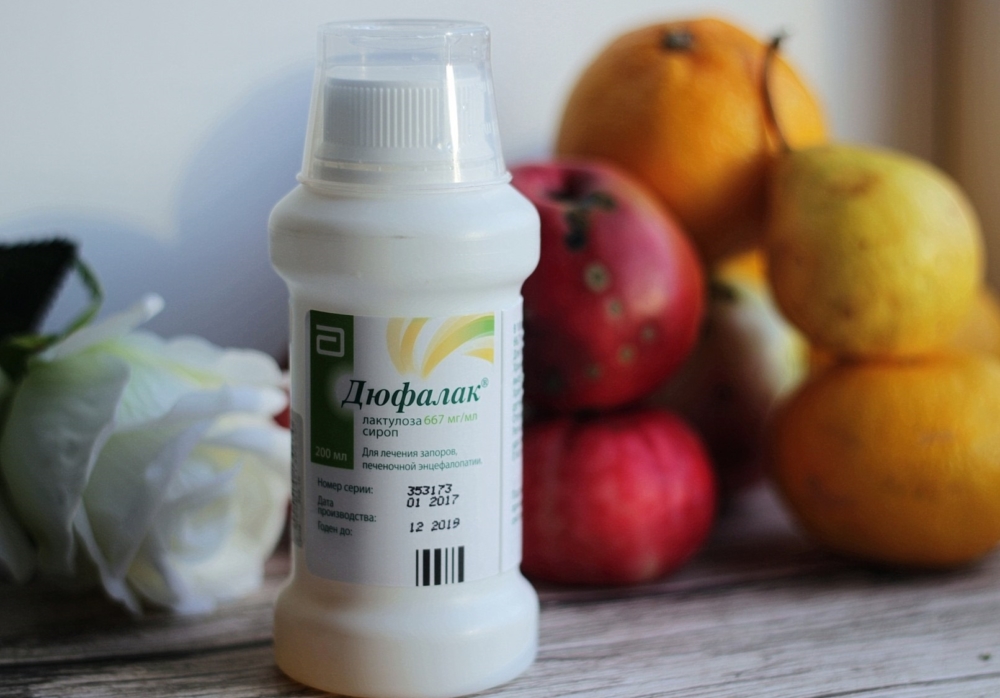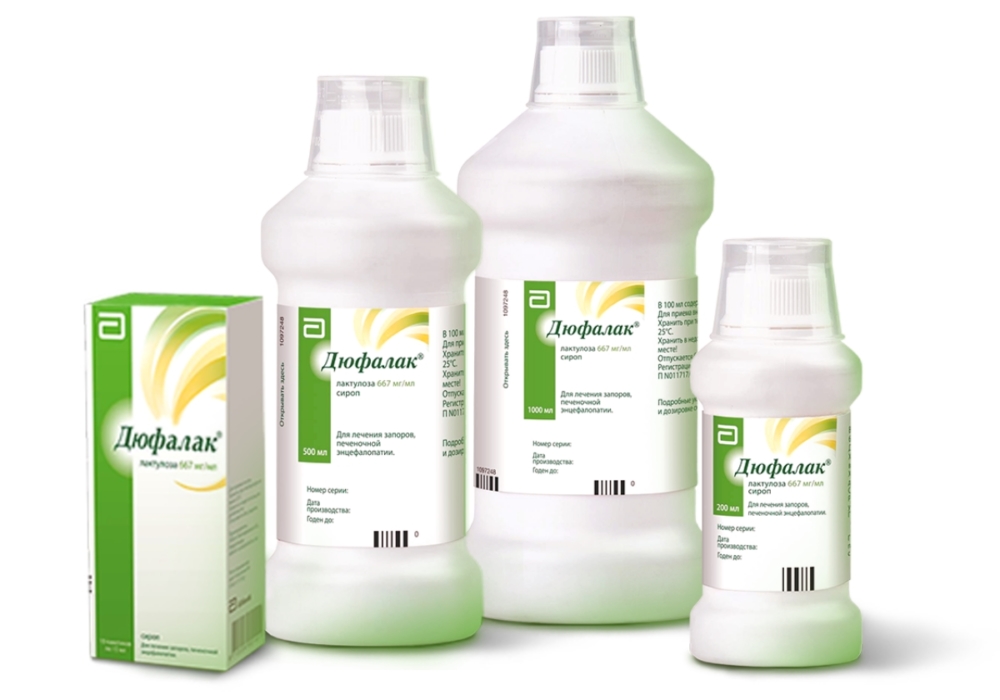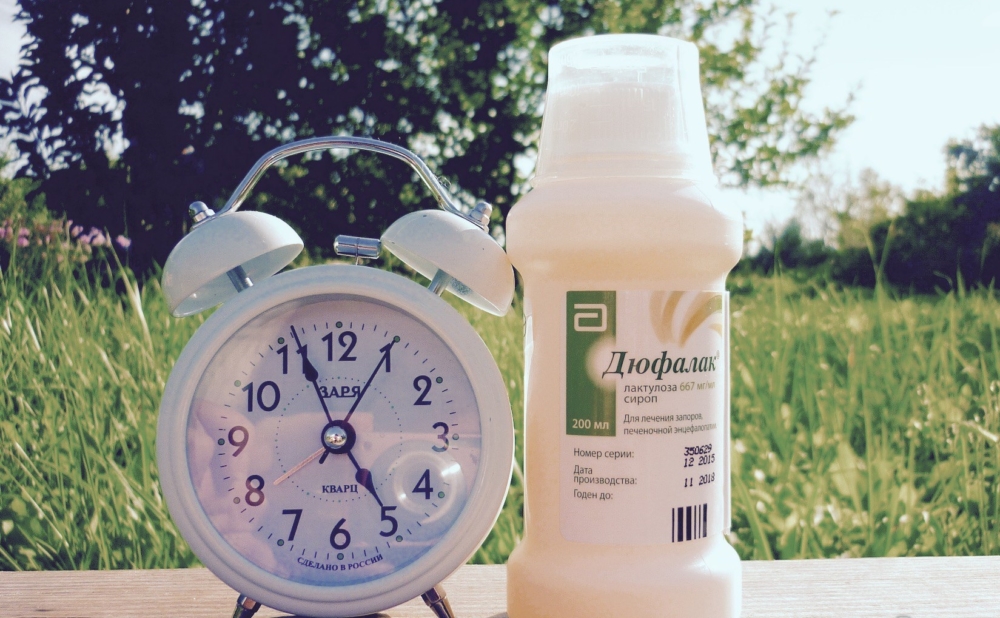All means that affect the digestive system work differently. The strength of its action and the time during which it will have a therapeutic effect depends on how to take Dufalac. The treatment regimen and course are related to the patient’s diagnosis and state of health.
Material Content:
What helps Dufalac
Duphalac syrup consists of lactulose and water. The active substance in it is 66.7 g, and the rest of the liquid composition in an amount up to 100 ml is water. The product is poured into soft plastic bottles with a volume of 200, 500 or 1000 ml. Each bottle is closed with a screw cap, in a package of thin cardboard there is also a detailed instruction for use and measuring dishes. There is a form of release in individual bags of foil and polyethylene with a volume of 15 ml. 1 box contains 10 such doses.
Dufalac belongs to the category of laxatives. In this regard, it is used in several cases:
- with a stool delay of more than 48 hours;
- to establish a normal rhythm of the intestines;
- prevention of injuries after surgical treatment in the anus or rectum;
- relief from hemorrhoids;
- violation of the intestinal microflora;
- encephalopathy of hepatic origin - helps to relieve the course of precoma and coma associated with liver failure;
- salmonella or shigellosis enteritis;
- putrefactive dyspepsia syndrome in childhood due to food poisoning;
- asymptomatic carriage of salmonellosis.
You can use Dufalac for constipation as a single drug, and in other cases it will become a component of complex therapy.This is due to the etiology of diseases, which involves treatment with drugs of other groups. In this case, one should take into account the possibility of their interaction in the intestine and choose the right dosage for the best effect.
How long does the drug work?
The speed of influence of the drug depends on the indications, the patient's condition and sensitivity to the active component. To solve problems with constipation lasting less than 7 days, it may take from several hours to 2 days. Dufalac gently launches intestinal motility, as a result of which the stool retention will be eliminated.
If this condition lasts more than a week, and problems with stool occur regularly, treatment will take a greater amount of time. This is due to the fact that the drug should help establish the rhythm of the systematic work of the intestine. For several doses of the medicine, you can get only a single effect, which will not continue after the end of therapy.
For preventive purposes and to facilitate the bowel movement during hemorrhoids and surgical treatment of the lower gastrointestinal tract, Dufalac acts quickly. In such cases, the intestine is free, and lactulose immediately affects its walls, so the result can be obtained in a few hours.
With an infectious lesion of the digestive tract or an imbalance in the microflora, the drug should be taken throughout the course of treatment. It helps the intestines to work in the same mode, even taking into account the disease.
Attention! After a steady improvement in well-being, Dufalac should be withdrawn gradually, observing the patient's condition.
If worsening, syrup is recommended to be resumed. This will help accelerate the recovery of the body and make the patient feel better.
Instructions for use for adults and children
The drug is taken orally. It is best to do this in the morning while eating. The amount depends on the age of the patient and his diagnosis.
The treatment regimen for constipation looks like this:
- a child under 3 years of age requires 5 ml;
- from 3 to 6 years old children are prescribed from 5 to 10 ml;
- from 7 to 14 years, the dose is 15 ml;
- from 15 years and older use from 15 to 45 ml (start with a smaller volume, adding a little until the therapeutic effect is achieved).
With such a pathology, the main task of a laxative is the release of feces. After defecation has occurred, the patient is transferred to maintenance therapy:
- in children under 6 years of age, the dosage corresponds to the therapeutic;
- from 7 to 14 years take 10 ml;
- from 15 years and older, 10-25 ml is enough.
The main stage of treatment takes about 2 days. If over time no improvement has occurred, the amount of the drug is increased. In the complete absence of a therapeutic result, the drug is replaced by an analog.
If the patient is in a state of precoma or coma due to liver pathology, he is prescribed 30-45 ml of syrup 3 times a day. After this, the dosage is gradually reduced in order to find the optimal amount of the product that is required for a regular stool of soft consistency and a pH of 5 to 5.5 2-3 times a day. When the condition is critical, Dufalac is administered through an enema, maintaining the ratio of 300 ml of the drug to 700 ml of water.
With bloating or imbalance in the intestinal microflora up to a year of age, children Dufalac is prescribed 1.5-3 ml per day. From 1 year to 3 years, the volume is 3 ml, from 4 to 7 years, the amount increases to 5 ml, and from 7 years it is recommended to take 10 ml of the drug per day.
Attention! If the symptoms of flatulence do not go away, the dosage can be gradually increased until the optimal amount of the drug is found for a particular patient.
Therapy of shigellosis and salmonellosis takes 10 to 12 days. During this period, children and adults should take Duphalac 15 ml 3 times a day. Then they take a break for 7 days. After this, the course is repeated with the same dosage, but the frequency of administration increases up to 5 times a day.
During pregnancy and lactation
During the bearing of a child, women often have problems with stools. This is due to the pressure of the fetus on the intestine and the deterioration of its peristalsis. Duphalac during pregnancy and breastfeeding is absolutely safe and can be safely used by expectant mothers to normalize their well-being.
Drug interaction
Lactulose is able to reduce pH in the large intestine. Therefore, the simultaneous administration of funds that are activated in an acidic environment (salicylates) will not have a therapeutic effect. Such combinations should be avoided for reasons of expediency of the use of drugs.
Contraindications, side effects and overdose
Dufalac is not among the potent medicines, so the contraindications to its use are very limited:
- increased levels of galactose in the blood;
- intestinal obstruction;
- hyperreactivity with respect to lactulose, fructose, lactose or galactose.
Patients with diabetes should use the medicine with caution, since its active component in the digestive tract breaks down into sugar. In some cases, there are side effects from treatment with Dufalac:
- epigastric pain;
- diarrhea;
- displacement of water-electrolyte equilibrium with a long intake;
- bouts of nausea;
- gagging.
If adverse events occur, stop taking the drug and consult a doctor. If you repeatedly exceed the dosage of the medicine, pain in the stomach and diarrhea appear. This condition also requires drug withdrawal and a visit to a medical facility.
Dufalac refers to safe and effective drugs that improve the work of the digestive tract. It is approved for pregnant and lactating women, who are often prone to problems with the functioning of the intestines. The medicine has a limited list of contraindications and side effects, which makes it popular among both doctors and patients.
















